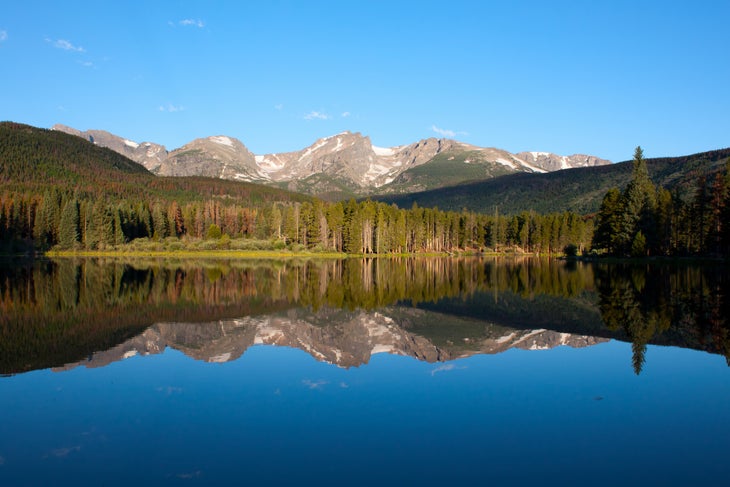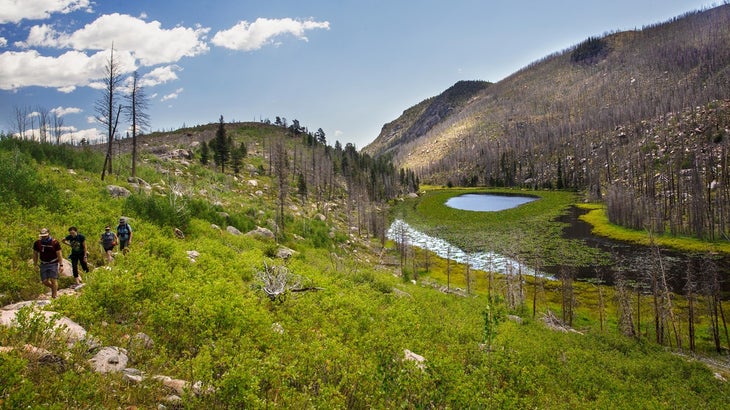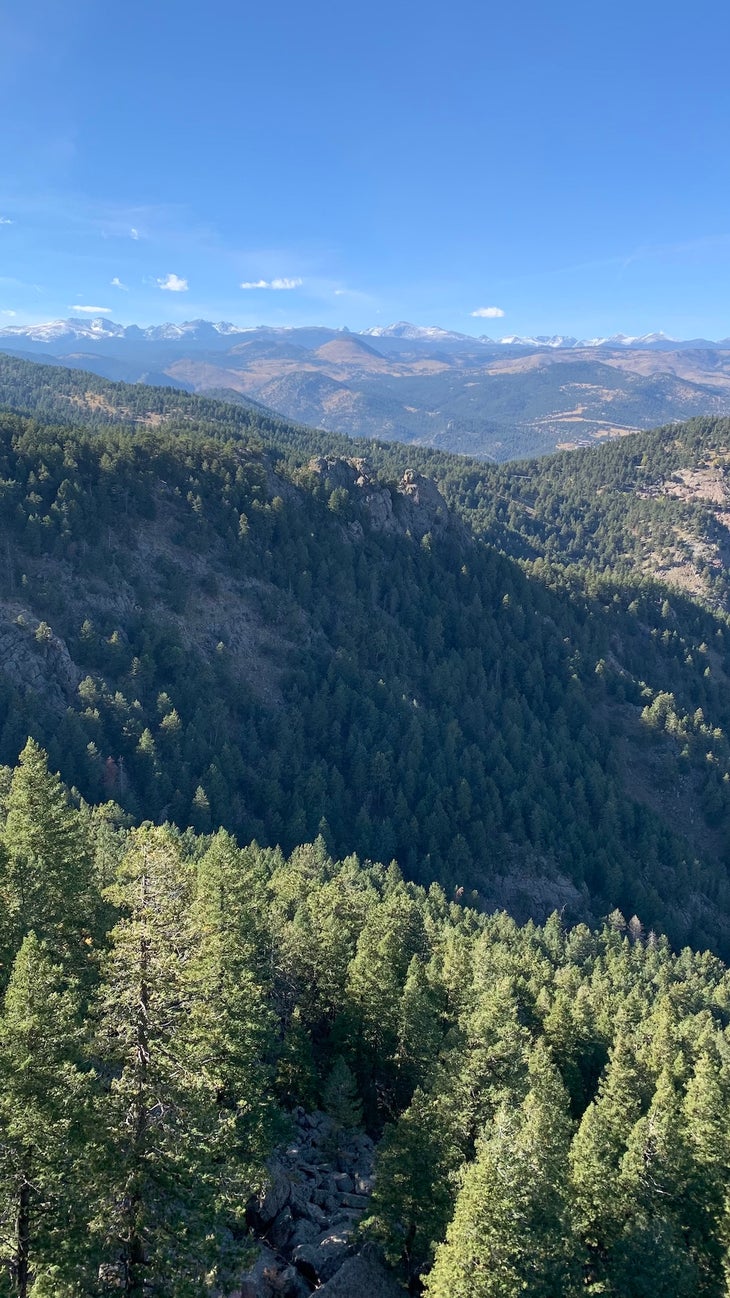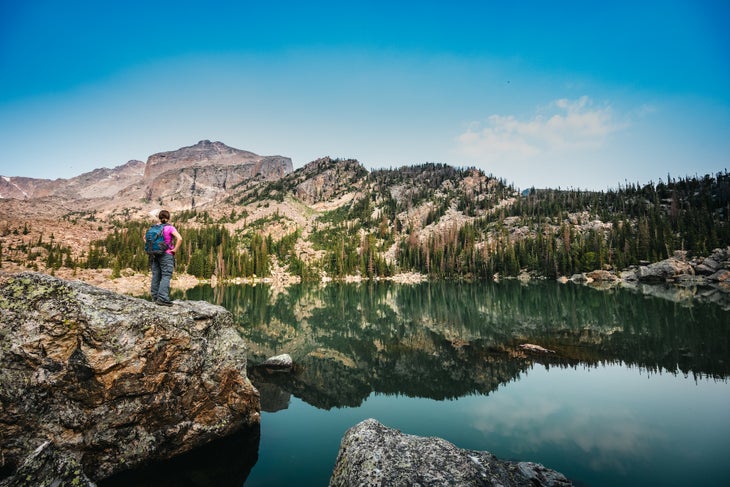Heading out the door? Read this article on the new Outside+ app available now on iOS devices for members! Download the app.
With over 350 miles of trails, Rocky Mountain National Park is a hiker’s paradise. There are almost too many alpine lakes and mountaintop vistas to choose from, so we curated our favorites to guarantee a memorable trip to this iconic Colorado destination. The trails on this list range from a 0.7-mile stroller-friendly loop to a 30-mile backcountry adventure Whether you’re a seasoned backcountry explorer, a dayhike aficionado or a family with young kids, we’ve got the right trail for you. Read on to find our picks for the 10 best hikes in Rocky Mountain National Park.
Flattop Mountain
Start: Bear Lake Trailhead
Style: Out-and-back
Distance: 8.5 miles
If summiting Longs Peak (a day-long endeavor that requires scrambling skills) isn’t on the menu, but you’ve still got a craving for a tough alpine ascent, Flattop Mountain is a great choice. Climb nearly 2,900 feet in elevation to gain the summit, and enjoy views of Dream Lake and Hallet Peak.

Sprague Lake Loop Trail
Start: Sprague Lake Trailhead
Style: Loop
Distance: 0.7 miles
This flat trail consisting of boardwalks is stroller-friendly and perfect for young kids just starting to get comfortable in the outdoors. The whole family can walk around the lake and see peaks on the Continental Divide in the distance. It’s common to spot wildlife—including beaver and moose—on this trail.

Cub Lake Trail
Start: Cub Lake Trailhead
Style: Out-and-back
Distance: 4.6 miles
Families with older kids who have their sea legs will love Cub Lake Trail. With just 540 feet of elevation gain, the 4.6-mile trail is relatively accessible and shouldn’t take more than a few hours. For those visiting in the fall and looking for photo-worthy foliage, this trail is widely known as one of the best hikes in Rocky Mountain National Park for leaf-peeping.
Fern Lake Trail
Start: Fern Lake Trailhead
Style: Out-and-back
Distance: 7.6 miles to 10.5 miles
Fern Lake Trail is one of the park’s best choose-your-own adventure options. Hike the standard 7.6 miles to Fern Lake, add the 0.9 spur trail to Spruce Lake or add another 2 miles to reach Odessa Lake. The views at Fern are hard to beat: You’ll see Notchtop Mountain, Little Matterhorn, Knobtop Mountain, and The Gable, peaks all standing over 11,000 feet. The trail, which runs along the Big Thompson River, is also popular with people looking to fish.
Continental Divide Loop
Start: Green Mountain Trailhead
Style: Loop
Distance: 30 miles (varies slightly based on campsites selected)
If you’re looking to get a true taste of the backcountry, the Continental Divide Loop should be on your tick-list. This loop covers most of the Continental Divide National Scenic Trail that passes through the park. Follow the Green Mountain, Tonahutu and North Inlet trails for a remote wilderness experience. Hikers will see Granite Falls, Mount Patterson, Snowdrift Peak, Flattop Mountain, and Cascade Falls. Overnight stays require a permit, which are available at recreation.gov and then must be picked up in person.

Sky Pond
Start: Glacier Gorge Trailhead
Style: Out-and-back
Distance: 8.6 miles
If you’ve only got one day in the park and are looking to get the most out of your time, this trail is an excellent option. Its 8.6 miles will bring you to many of the park’s highlights, including Alberta Falls, Timberline Falls, Lake of Glass and Sky Pond, with views of Taylor Peak and Powell Peak to accompany you.
Bluebird Lake Trail
Start: Wild Basin Trailhead
Style: Out-and-back
Distance: 13.3
At just over 13 miles, this trail is a great candidate for an easy overnight backpacking trip. There are several wilderness campgrounds along the trail, including Upper Ouzel Creek, Ouzel Creek, and Tahosa. In addition to Bluebird Lake, hikers will also see Copeland Falls, Ouzel Falls, and Ouzel Lake for a true smorgasbord of the best the park has to offer.

Lake Haiyaha
Start: Bear Lake Trailhead
Style: Out-and-back
Distance: 4.2
With just 745 feet of elevation gain, the trail to Lake Haiyaha is one of the best moderate trails in the park. Hikers get some of RMNP’s signature elements, including views of Bear, Nymph, and Bierstadt lakes, without the steep, difficult ascents common in other parts the park. It’s possible to add on another mile to see Alberta Falls, and thereby turn the trail into a loop.
East Inlet Trail
Start: East Inlet Trailhead
Style: Out-and-back
Distance: 0.6 to 18 miles
The East Inlet Trail is another great trail with a lot of options. Travel just 0.6 miles out-and-back to see the charming Adams Falls, or go all the way to Fifth Lake and complete the full 18 miles. It’s easy to split up the trail, with Lone Pine Lake, Lake Verna, Spirit Lake and Fourth Lake spaced out evenly along the trail. If you’re visiting in the spring, this area is one of the best hikes in Rocky Mountain National Park for viewing wildflowers.
Black Canyon Trail
Start: Lumpy Ridge Trailhead
Style: Out-and-back
Distance: 17 miles
Anyone who’s been in Estes Park in June knows that the park can be absolutely slammed with visitors in the summer. If you’re looking to escape the crowds, embark on this trail, which tends to be less popular but equally as gorgeous as the marquee hikes. Fair warning: With over 4,000 feet of elevation gain, only experienced hikers should attempt this trail.
What to Know About Hiking in Rocky Mountain National Park
Rocky Mountain National Park uses timed entry reservations during the busiest part of the season. In 2025, it will require visitors who plan to come between 9 a.m. and 2 p.m. daily from May 23 to October 13 to book in advance. Reservations come in two flavors, Timed Entry, which allows visitors to access all areas except for the popular Bear Lake corridor, and Timed Entry+, which opens up the entire park. No matter which you have, you’ll have a two-hour window to enter. Backpackers with a permit do not need a timed entry reservation. Campers with a reservation can also enter without a permit, though which areas you have access to depends on where you’re staying.
Weather changes quickly in Rocky. At higher-elevation destinations like Longs Peak or Trail Ridge Road, it can snow in all months of the year. During most of the summer, thunderstorms—a significant danger above treeline—are nearly a daily event. Carry an insulating layer and a light shell in your daypack even in summer, and keep a close eye on the weather forecast before you embark (check with a camp host or ranger station if you can’t get reception).
Rocky Mountain National Park is a great place to see wildlife—some potentially hazardous. Several dozen black bears call the park home, and the park requires anyone staying overnight in the backcountry to carry a bear canister. Don’t underestimate the moose or elk, both of which are very large and regularly come into conflict with uninformed tourists in nearby Estes Park, either.
From 2025